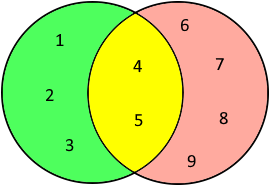Set Difference
Calculator for computing set differences with comprehensive formulas and examples
Set Difference Calculator
What is calculated?
The set difference A \ B contains all elements that are in the first set A but do not occur in the second set B.
Set Difference Info
Properties
Set Difference A \ B:
- Contains only elements from A
- Excludes all elements from B
- Not commutative: A \ B ≠ B \ A
- Can be empty: ∅

Venn diagram of set difference
Memory aid: "A minus B are all A-elements without the B-elements."
Examples
{1,2,3} \ {2,3,4} = {1}
{1,2} \ {3,4} = {1,2}
{1,2,3} \ {1,2} = {3}
Related Operations
|
|
Set Difference Formulas
Basic Definition
Alternative Notation
Symmetric Difference
Relative Complement
Commutativity
Associativity
Detailed Calculation Example
Example: A = {1,2,3,4,5}, B = {4,5,6,7,8,9}
Given:
- A = {1, 2, 3, 4, 5}
- B = {4, 5, 6, 7, 8, 9}
Step 1 - Check elements from A:
Step 2 - Result:
Compare B \ A:
Interpretation: The set difference A \ B contains only the elements 1, 2, 3, which occur exclusively in A.
Practical Application Example
Example: Member management in a club
All members (A):
Anna, Ben, Clara, David, Eva, Franz, Greta, Hans
Paying members (B):
Clara, David, Eva, Franz, Ines, Jörg
Question: Which members haven't paid yet?
Result: 4 members still need to pay their dues.
Set Difference Laws
Important properties and laws
Identity
Difference with empty set
Self Difference
Set minus itself
Distributivity
Distribution over union
De Morgan
Distribution over intersection
Important: Set difference is neither commutative nor associative!
Mathematical Properties
Basic Properties
- Uniqueness: A \ B is uniquely determined
- Subset: A \ B ⊆ A (always)
- Disjointness: (A \ B) ∩ B = ∅
- Cardinality: |A \ B| ≤ |A|
Special Properties
- Not commutative: A \ B ≠ B \ A
- Not associative: (A \ B) \ C ≠ A \ (B \ C)
- Monotonicity: If B ⊆ C, then A \ C ⊆ A \ B
- Complement relation: A \ B = A ∩ B̄
Practical Notes
Order matters: A \ B is not the same as B \ A
Visualization: Venn diagrams help with understanding
Practical Applications
Databases
- SQL EXCEPT operations
- Data cleaning
- Duplicate removal
- Difference analysis
Administration
- Member management
- Participant lists
- Inventory comparisons
- Finding missing elements
Programming
- Set operations
- Filter algorithms
- Exclusion logic
- Difference calculations
|
|